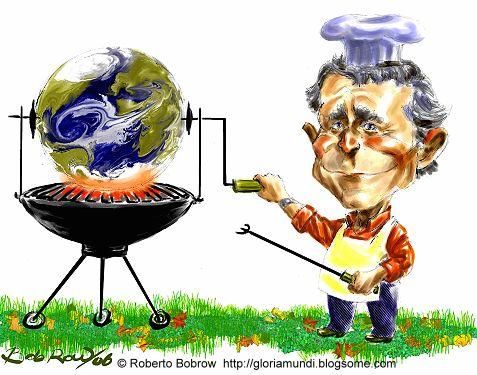It All Depends On Who's Talking
 Here's one story opined on in two very different ways. It's about EPA Chief Stephen Johnson doin' some 'splaining in DC yesterday to very irritated Dem Sens about EPA's alleged foot-dragging on implementing CO2 regulations.
Here's one story opined on in two very different ways. It's about EPA Chief Stephen Johnson doin' some 'splaining in DC yesterday to very irritated Dem Sens about EPA's alleged foot-dragging on implementing CO2 regulations.Here's how WaPo's In the Loop columnist Al Kamen saw it:
Environmental Protection Agency chief Stephen L. Johnson infuriated pro-enviro lawmakers once more with his decision yesterday when he tightened ozone standards to a lesser degree than his scientists advised.Gee, what a terrible man this Johnson must be, running a renegade EPA that exists only to carry out the earth-stomping, air-befouling, water-wrecking whims of George "that W's for 'Big Oil'" Bush, right?
But he's proved himself more than capable of deflecting apoplectic members of Congress critical of his unusual stewardship of the nation's environment. Note for example, his handling of Sen. Dianne Feinstein (D-Calif.) at a recent Senate hearing.
Feinstein, who chairs the Appropriations subcommittee that controls the EPA's budget, asked why Johnson had not yet complied with a Supreme Court ruling a year ago in Massachusetts v. EPA that required him to come up with ways to regulate greenhouse gases.
"I find this unbelievable on behalf of what is called an environmental protection agency," Feinstein said, "and there's a finding of the United States Supreme Court telling you to do something."
"Well, Madam Chairman," Johnson eloquently intoned, doing a spectacular imitation of Mr. Magoo wandering about in the smog, "I respectfully disagree that this is an easy decision. . . . I think Justice Scalia actually set it up as, in essence, a three-part test for me and this would be my brief summary, and that is: If the agency finds -- if I find that there's endangerment, then under the Clean Air Act I must regulate. If I find that there is not, that's test one. If I find that there is not endangerment, then I should not regulate. Or third, if there are other circumstances . . . "
Huh? At any rate, it's clear that Johnson has paid careful attention to the Supreme Court decision and is adhering to Justice Antonin Scalia's concise test.
One small problem: Scalia dissented in that ruling.
Well, maybe not. Here's how the WSJ editorial page covered the same story:
Combine the Bush White House, global warming, and a policy conclusion that environmentalists don't like, and the dudgeon is bound to be high. Even so, it's been stratospheric since the Environmental Protection Agency denied California special permission to regulate greenhouse gases. Senator Barbara Boxer draws parallels to Watergate, "the most infamous cover-up in history," while Senator Bernie Sanders so savaged EPA chief Stephen Johnson during a recent hearing that he was reduced to pleading, "I consider myself to be a human being."Granted, Kamen's piece has some punch that the logical, reasonable and entirely sane WSJ piece lacks. But in addition to punch, Kamen offers up opportunism, shallowness and emotional manipulation. No wonder Greenies and Libs love WaPo and hate the WSJ.
Not to spoil the party, but this is the outrage of sore winners. True, the EPA's ruling is a minor setback for the global warmists. But it may pour the bureaucratic foundation for their larger policy goal, which is economy-wide regulation of carbon dioxide. Worse, the Bush EPA may do so by rewriting current environmental law, with little or no political debate.
The fracas concerns California's attempt to limit CO2 emissions via the federal Clean Air Act, which allows state air-quality standards that are stricter than Capitol Hill's. By California's reasoning, climate change is an air-quality problem, caused by a "pollutant," CO2, that goes into the air. Ergo, the state is entitled to a waiver. Not coincidentally, this is also the pet theory of the environmental left, which wants the EPA to declare greenhouse gases a threat to humanity. Last year, the Supreme Court agreed, to a point. It ruled that the EPA must determine whether or not carbon "endangers public health and welfare," and that if it does, the agency must regulate. That process is now underway.
The reason the EPA has never included CO2 with pollutants restricted by the Clean Air Act, like NOX or SOX, is that it is fundamentally different. It does not contaminate the air or make it unhealthy to breathe. It is natural: Think human respiration. Because there's no technology that can limit its release as carbon fuel combusts, it is unavoidable. Plus, when the Act was amended in 1990, Congress specifically rejected provisions for greenhouse gases. ...
The EPA avoided a bad precedent, but conceded a lot. Legally, Mr. Johnson concludes that "warming of the climate system is unequivocal . . . very likely due to the observed increase in anthropogenic GHG concentrations" and refers to climate change as "a fundamentally global air pollution problem" and CO2 as "a global pollutant." These assumptions matter as the agency lurches toward the larger "endangerment finding." If CO2 is classified as a "pollutant," it triggers a long sequence of regulatory booby traps, and the EPA staff, by law, is granted limited discretion as to enforcement or cost.
For instance, an endangerment finding must apply beyond cars and trucks to "stationary sources," i.e., buildings. The floor for EPA permitting rules is 250 tons of a Clean Air Act pollutant per year, sometimes as few as 100. Those limits might be reasonable for sulfur dioxide. But it's nothing for CO2. A midsized office building that uses fossil fuels for heating easily exceeds the threshold. So do almost all factories, farms, restaurants, schools, hospitals . . .
Another section of the Clean Air Act requires the EPA to reduce the concentration of a pollutant to an "adequate margin of safety." Even if the U.S. were diminished to North Korean energy levels tomorrow, it would have almost no effect on global temperature. But the EPA would be pressured to set standards below what they are now, creating a de facto carbon cap. ...
The Supreme Court did not require the EPA to change its position on CO2, only to justify it within the scope of the Clean Air Act. In fact, the Court said the agency could defer a judgment because the science is complex and still evolving. But Mr. Johnson's waiver decision welds shut that escape hatch -- and he's still getting pounded by Democrats.
Illustration: Gloria Mundi
Labels: Climate change, Global warming, Media bias, Stephen Johnson




<< Home